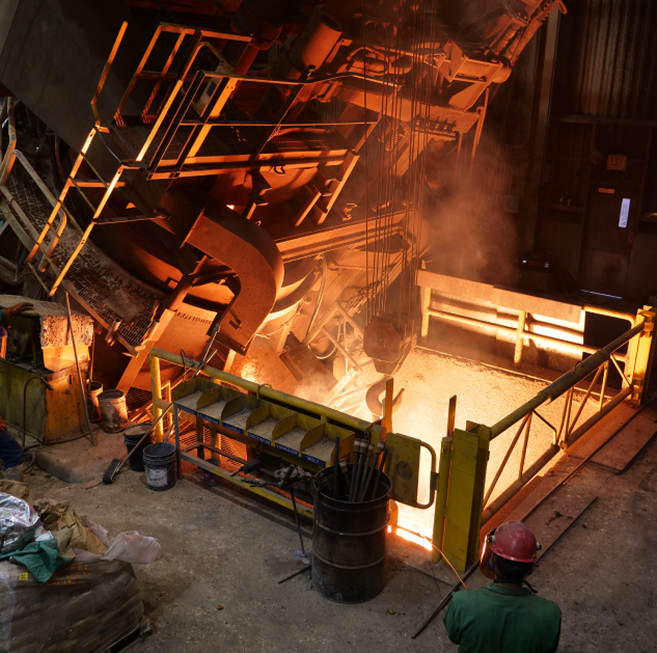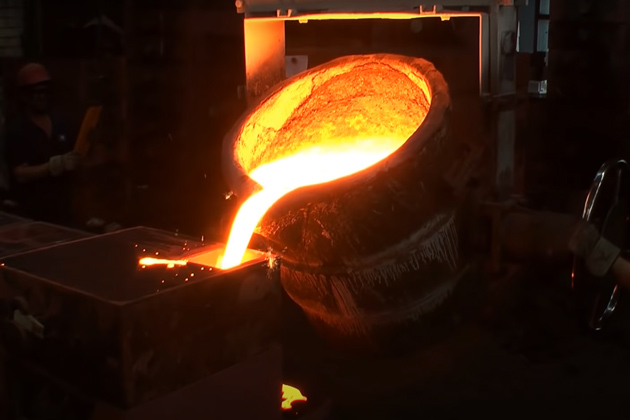Discover the Innovative Strategies Utilized in a Metal Foundry for Superior Casting Results
In today's competitive production landscape, metal foundries are progressively taking on ingenious techniques to boost spreading outcomes - Aluminum Foundry. Advanced computer system simulations enable specific modeling of molten metal behavior, while 3D printing makes it possible for rapid manufacturing of complex mold and mildews. Additionally, environmentally friendly products and automation simplify operations. These growths guarantee considerable enhancements in effectiveness and high quality control. The influence of these technologies on sustainability and manufacturing methods continues to be to be fully discovered.
Advanced Computer Simulations in Metal Casting
Advanced computer system simulations have revolutionized the metal casting process by improving accuracy and efficiency. These sophisticated tools enable designers to develop virtual designs of cast components, enabling them to evaluate and predict the habits of molten metal during the spreading phase. By replicating various parameters such as temperature, circulation price, and air conditioning prices, producers can identify possible flaws prior to physical manufacturing begins.
This aggressive strategy decreases waste and decreases pricey errors, ultimately leading to boosted item top quality. In addition, simulations help with the optimization of mold layouts, guaranteeing that they meet the details needs of each project. The assimilation of computational liquid dynamics (CFD) and limited aspect analysis (FEA) further adds to the accuracy of these simulations, offering understandings that were previously unattainable. Consequently, progressed computer system simulations have become a vital part of modern metal foundries, significantly advancing the market's capabilities.
3D Printing for Molds and Patterns
3D printing has actually become a groundbreaking strategy for developing mold and mildews and patterns in the metal foundry sector. This innovation enables the fast manufacturing of complicated geometries that standard manufacturing techniques struggle to accomplish. By making use of additive manufacturing, foundries can produce intricate designs with minimized preparations and material waste. The capability to produce mold and mildews as needed enables better flexibility in design versions, facilitating faster prototyping and modifications.
Additionally, 3D printing can make use of a variety of materials, consisting of metals and plastics, customized to details casting needs. This adaptability improves the accuracy of mold and mildews, causing superior casting end results with boosted surface coatings. In addition, the reduction in the number of components required streamlines assembly processes, better maximizing manufacturing efficiency. As foundries continue to take on 3D printing, they are positioned to redefine industry criteria, leading the means for advancement and improved efficiency in metal casting procedures.
Eco-Friendly Materials and Processes
As the metal foundry sector faces raising pressure to lower its ecological impact, the fostering of green products and processes has actually come to be vital. Shops are currently checking out sustainable choices to conventional materials, such as utilizing recycled metals and bio-based binders. These materials not only minimize waste yet likewise lower power usage during manufacturing.
In addition, innovations in sand casting techniques have resulted in using artificial sands that are less hazardous to the environment. Shops are additionally executing innovative procedures like molten metal therapy that decreases emissions and boosts the high quality of actors products.
Moreover, water-based layers have actually changed harmful solvents, advertising a much safer job atmosphere (Metal Foundry). By integrating these eco-friendly methods, metal foundries can noticeably decrease their environmental influence while preserving high-grade spreading outcomes. This change not just benefits the environment but likewise straightens with the expanding customer need for lasting production remedies
Automation and Robotics in Foundry Procedures
While the metal foundry sector embraces innovation, the assimilation of automation and robotics is changing procedures substantially. Automated systems simplify processes such as mold production, metal pouring, and casting completing, greatly boosting efficiency. Robotics help with the handling of heavy products, lowering the risk of workplace injuries and making sure much safer settings.

Additionally, the usage of automated directed lorries (AGVs) maximizes material transport within centers, making certain prompt shipment of components to ideal workstations. By carrying out these innovations, foundries can adapt to varying needs with higher agility, inevitably resulting in boosted success and competitiveness in the market. As automation and robotics proceed to advance, they hold the possible to redefine standard foundry techniques and drive further improvements in casting methods.
Real-Time Surveillance and Quality Assurance Techniques
The improvements in automation and robotics have paved the method for extra sophisticated strategies to quality control in metal foundries. Real-time monitoring systems make use of sophisticated sensing units and data analytics to track essential specifications throughout the spreading procedure. These systems continuously analyze variables such as material, stress, and temperature make-up, enabling prompt detection of deviations from established requirements.
Quality assurance strategies now integrate equipment knowing formulas that examine historic information to forecast possible flaws before they occur. This proactive method lessens waste and boosts total production effectiveness. Furthermore, incorporated comments loopholes permit quick changes, ensuring that each casting meets stringent quality demands.
The application of electronic twins-- digital replicas of physical properties-- has also reinvented quality control, allowing engineers to simulate and enhance procedures in real-time. With each other, these ingenious techniques significantly improve the integrity and high quality of castings, establishing brand-new market requirements in metal foundry operations.
Often Asked Inquiries
What Kinds of Metals Are Commonly Cast in Shops?
Frequently cast metals in foundries consist of aluminum, bronze, brass, and iron. visit our website Each metal published here displays one-of-a-kind homes, making them suitable for different applications, such as auto parts, equipment, and artistic sculptures, improving their convenience in manufacturing.

How Long Does the Casting Refine Commonly Take?
The spreading process generally takes several hours to days, depending upon factors such as the complexity of the mold and mildew, kind of metal utilized, and air conditioning demands. Each stage influences the overall period significantly.
What Precaution Are in Area for Foundry Employees?

Exactly how Are Issues in Castings Identified and Addressed?
Defects in castings are identified via aesthetic inspections and non-destructive testing methods. As soon as detected, foundry workers address them by fine-tuning processes, adjusting material compositions, and applying corrective procedures to ensure top quality and conformity with standards.
What Is the Price Range for Metal Casting Solutions?
The expense range for metal casting solutions generally ranges $1 to $10 per extra pound, relying on aspects such as material kind, intricacy of the design, and production quantity, impacting total pricing considerably.
In today's affordable production landscape, metal foundries are progressively embracing innovative strategies to improve spreading outcomes. As the metal foundry industry deals with raising pressure to lower its environmental impact, the adoption of environment-friendly products and processes has come to be necessary. Foundries are now discovering sustainable options link to typical materials, such as utilizing recycled steels and bio-based binders. By integrating these environment-friendly methods, metal foundries can substantially decrease their ecological effect while keeping high-quality spreading outcomes. The innovations in automation and robotics have actually led the method for more advanced methods to high quality guarantee in metal foundries.